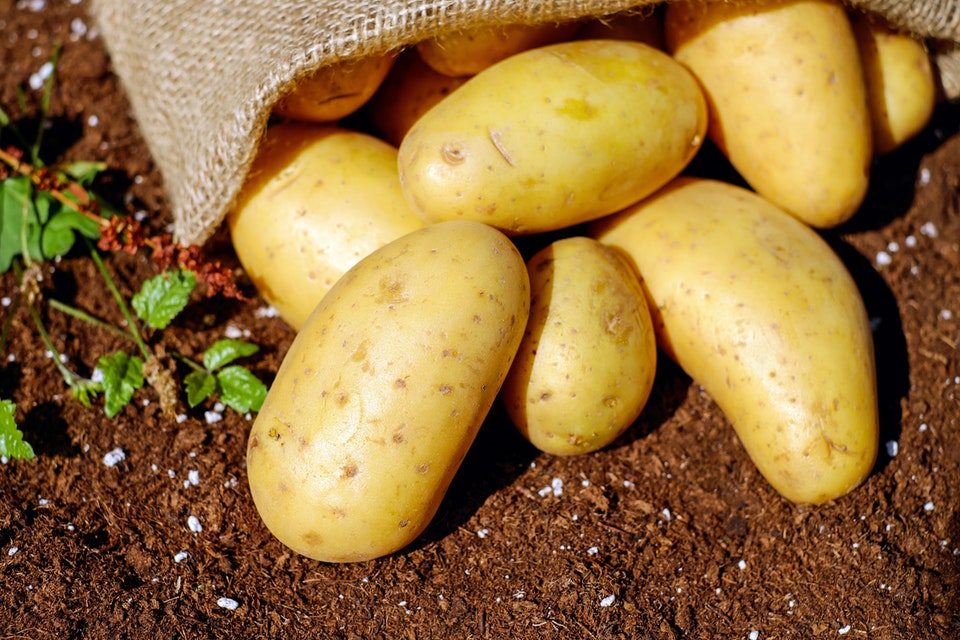Planting potatoes isn’t rocket science at all. I learned how to grow potatoes way before I was a seasoned gardener. However, it is an art, a science but still an easy experience. Moreover, it should not be done haphazardly and without proper information to help you.
Potatoes are easy to grow and produce great quantity harvests. You don’t need much to get started. They just need full sun; loose, yet fertile soil; and an inch of water each week. The best plan is to grow them in raised beds but you can also grow them in plastic buckets.
I want to give you some potato planting pointers critical to a successful harvest. I’ll cover the basics you need to know and all I’ve experienced. However, I’ll first describe the plant.
What Does Potato Plants Look Like?
I know that some, if not many, are asking, what do potato plants look like? It’s not really easy to recognize it. It doesn’t have any height or flamboyant characteristics to talk about. It doesn’t have unusual leaves or and it’s not an ornamental plant.
You could mistake it for a potato plant during its early stages. However, it’s the swollen parts of its roots that become what we eat. Its leaves come in different colors and sizes since it has more than 4,000 different varieties.
Here are steps to take during the growing potatoes process that definitely guide you how do potatoes grow.
1. Pick your Potatoes
There are 5,000 different varieties of potatoes across the globe. However, it’s only a handful of those varieties that we have access to. Just be clear about the characteristics of the ones you need. Is it the white-potato, baking potato, yellow Yukon or perhaps the beautiful red-skin?
I’d recommend you buy certified seed potatoes at a farm store. The ones from supermarkets aren’t suitable for planting since they’re treated with a sprout-retardant. In addition, when choosing from that farm store or catalog, go for the organic, certified disease-free seed potatoes.
When choosing, select tubers that have already sprouted to jumpstart their growth process. You will harvest pre-sprouted ones a few weeks earlier than the non-sprouted ones. You can, however, pre-sprout them simply having them laid out on your kitchen counter or something like that.
2. Cut Tuber before Planting
Cut your tubers into pieces into sections. You need each segment to have two or three eyes. By “eyes”, I’m referring to those tiny bumps from which the sprouts emerge. You are cutting them to reduce the number of eyes on a potato.
Many eyes on a potato produce a crowded multi-stemmed plant. This leads to each stem competing for food, nutrients, and moisture. And in the end, you only bear smaller potatoes. But make sure your pieces are not too small. The smaller the piece, the weaker the end plant.
(This is fairly arguable, as there are many other factors involved besides the size.)
3. Curing the Pieces
Most gardeners dislike this entire practice because cutting increases chances of rot. Well, let me assure you that rot can be prevented. There is a process to cure the cut sections.
Place the pieces on any area with light and temperatures between 60-70 degrees F. Or on a table in a warm and moderately lit room for three to five days. Or just set them out in the sun. It allows the cuts to become calloused. And it is that calloused seed potatoes that help prevent rot.
4. Planting the Potatoes

First, remember they grow best in full sun. Their rooting system is aggressive. Therefore, you need to plant them in a light, loose, and well-drained soil. Preferably, a bit acidic soil with a pH of 5.0 to 7.0. For best results, keep its patch free from weeds.
When you’ve found the perfect area, plant each piece’s eyes up and cut-side down. Plant in a 6-inch deep hole or trench and space each segment 12-inches apart on all sides. Sprinkle 2 tablespoons of a low-nitrogen, high-phosphorus fertilizer between each segment.
Next step is using 2-inches of soil to cover the potatoes and the fertilizer. Then finally water the soil well.
5. Caring for the Potato Plant
As sprouts continue to grow, it’s necessary to “hill” the vines. Potatoes develop from the sprouts that turn into stems and leaves. So when the green sprouts reach 8 inches in height, mound the topsoil around them and bury about 4 inches to the top.
It’s what is commonly known as “hilling”. It prevents sunburn and allows your plant to produce more potatoes. You can hill with soil, chopped straw or shredded leaves. Hill again when it’s about a foot in height again. Potatoes tubers need to live in darkness.
(It’s crucial to keep tubers covered with soil or much. If exposed to light, they turn into green potatoes, which can cause sickness when consumed.)
The new baby potato is formed along the stem’s underground portion. The more you hill, the more you provide underground stem area for production of spuds.
6. Harvesting Potatoes
When potato plants flowering begins, stop hilling, and reach into the soil or mulch and retrieve some baby potatoes. They are delicate, thin-skinned and can be easily damaged. Therefore, you need to use a small trowel (or tool) around the plant.
Then spread soil or mulch around the remaining vines. This conserves moisture and it’s bad for weeds. Otherwise, just wait for the vines to die, which is a great sign to tell tuber has reached maturity. Then you can just dig out into the soil, even with your hands, and pull the tubers up.
You can also cut the tops of the potatoes when they start turning into a brown color. If you leave the potatoes underground for two to three weeks, they get more time to develop harder skins. It’s best to dig them out during a dry day. Wet and muddy soils are more difficult.
Since they aren’t baby potatoes anymore, it’s safe to use a shovel or fork to dig them out. You still have to be careful through the whole process though.
Finally, all you have to do is to store your freshly dug potatoes. You have to lay them on the ground for a few hours or until cool weather arrives. It’s meant to make their skin tougher. Because potatoes only store best in cool dry places. Move them to a cool and dry storage place for about two weeks.

Leave a Reply